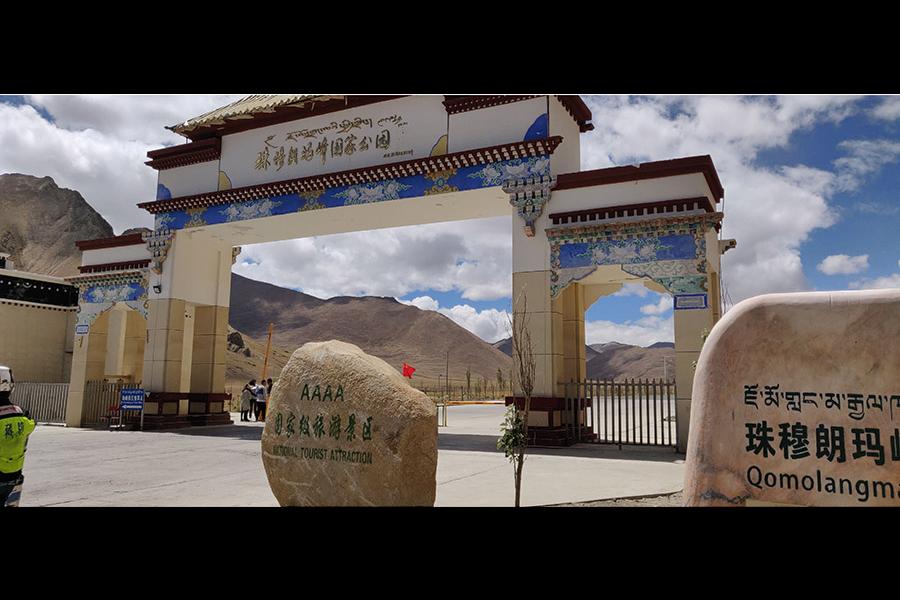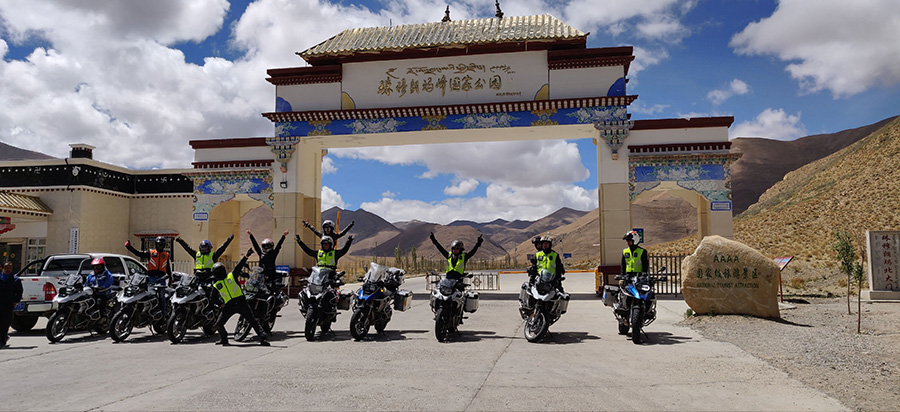India to London road trip: Magnificent Mt Everest and rigorous Chinese inspections
As we entered China, rigorous inspections became a part of our travel itinerary as we continued our journey ahead
Gyirong to Tingre via Everest Base Camp
On June 11, we first headed to the gas station, where I was taken aback by the exhausting process to refuel our car and bikes. First, our guide, Tenzin, rushed to the payment counter and got us a slip. Next, we were handed over the diesel in an aluminium container shaped like a watering can. It took Tenzin three trips to and from the gas station to complete refuelling our vehicles.
We drove to Tingre, some 268 kms away and stopped at a waterfall in between. Tingre is at a height of 2,400 metres. Everest Base Camp, to which we would drive on the second day, is at approximately 5,000 metres above sea level, and participants were worried about acclimatisation. A veteran mountain climber advised us to start taking altitude sickness medicine two days before getting to Everest Base Camp. Most of the team did, but even so, the photographer, Imtiaz Ansari, and I got altitude sickness the next morning. It became difficult to breathe, and to lift our luggage from the hotel's second floor was tedious. We decided that the two of us would stay back at the Everest Base Camp ticket counter, and the rest would ride to see the Everest from the Tibetan side.
Tingre to Shigatse
On June 12, we started for Everest Base Camp (EBC) at 5 am from Tingre and reached the ticket counter at 6 am. The three riders, with the guide and mechanic, drove to the EBC some 40 km above. When you drive up, the vehicle has to be parked 13 km short of the EBC for environmental reasons; then, the group gets into a bus to see Mt Everest. The sun was out and they got a good view of the mountain. While the rest of the team was gone, the photographer and I rested for a good five hours in the car, with the heater on. This helped us immensely with our altitude sickness. The riders returned with frozen hands from riding in the cold, shivering.
Along the way, we saw numerous prayer flags tied to the pass. I noticed a pile of yak horns, which may have been offerings for the Gods there. The more we delayed crossing the pass, the more laboured our breathing became. One technically should not stop at any pass for more than 10 minutes, as the air is very thin and the oxygen levels are low. I started to recite the Gayatri Mantra, and the meditation helped me resume normalcy after some time.
The roads were good but it was very cold indeed. We ate from instant food packets at lunch, in a rural Tibetan dhaba, where locals played snooker in the open air. After lunch, we drove past a huge, pristine-blue lake, called Pikutso. It had a soothing effect on all of us. We stopped for a few minutes here to gaze at the mesmerising waters, and got a full view of the Himalayan range. Then we set out for Shigatse, a Chinese city about 235 km away.
We targeted 3 pm, but reached much later in the evening, as the guide had to start the formalities to get a Chinese drivers' license and number plate for all. In the evening, Tenzin took us to a Nepalese restaurant, Tashi, where we ate Indian food. The participants were happy.
We were up early on June 13 and began our paperwork for the upcoming journey. We were taken to a huge compound, which had 100s of vehicles lined up. Tenzin was taken aback as usually, only a few vehicles are here for inspection. We later found out that the internet was down the previous day, causing a pile up. It is mandatory for all vehicles go through an annual inspection. Since we were tourists, we were taken through a priority line.
The inspection starts from the weight of the car. A huge machine that looks like a scanner checks each head light, side light and tail lights. The front tyres are put on rollers and brakes applied, and the same is done with the rear tyres. After a computerised report is generated, the inspection officer approves it. My car is just two months old, so there were no issues. I thought this was it, but this was just the beginning. Tenzin was tense, as he knew we could run out of time, but we didn't believe him. We went to a police station where Tenzin had to register the Vehicle OK reports, and several government offices after that, each of which required to see our passports and Chinese visa.
From noon to 3.30 pm, all government offices are closed. Where we had lunch, I saw locals sit by the side of the pavement and play some Chinese board games. It seemed like they were gambling.
From here, Tenzin took us to a huge and impressive government hospital, where we all had to take an eye test. The Chinese have a different way of checking the eyes. Instead of reading alphabets, we had to show the direction of the letter “E”, which was shown facing upwards, downwards, left or right, as the letters got smaller. From here, we went to the police headquarters for our Chinese driving license and Chinese number plates. All forms and formalities were in process, when an officer pointed out that there was an issue with one of the documents.
Tenzin was nervous. In the meantime, our Chinese number plates were issued and we were asked to leave the police headquarters immediately. Tenzin told us to drive around the corner and wait for him. We waited for his phone call. After more than two hours, he frantically called and asked if one of us could take him to another office on the motorcycle. One of our riders picked him up and rushed to the same office we had gone to in the morning for vehicle inspection. One of the bike documents had a typing error in the engine number. Within minutes, the government offices were about to close. But our rider rode like the wind, and finally, at 7 pm, we got our documents cleared. Tenzin mentioned that sometimes, it can take up to two days to get all permissions. All of us thanked Tenzin, our superman, for his good work, and stayed back in Shigatse for the night.
Read the previous part of the travel blog series here.
The author is a motorcycle enthusiast who realised his dream of riding across the world in his 50s, despite three heart attacks
The thoughts and opinions shared here are of the author.
Check out our end of season subscription discounts with a Moneycontrol pro subscription absolutely free. Use code EOSO2021. Click here for details.
-
 KS chhabra
KS chhabraGod Bless... May HE himself be your SARTHI all through your DREAM PATH...
on Aug 8, 2019

